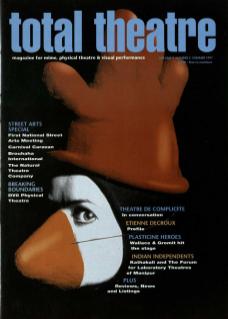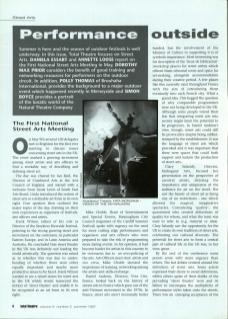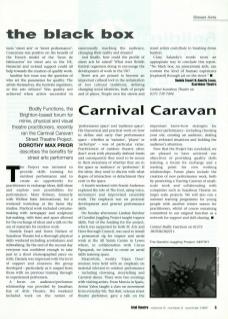On 9 May around 150 delegates met in Brighton for the first ever meeting to discuss issues concerning street arts in the UK. The event marked a growing movement among street artists and arts officers to find a workable way of describing and defining street art.
The day was chaired by Ian Reid, the Director of Combined Arts at the Arts Council of England, and started with a welcome from Linda Lewis of South East Arts Board. Linda introduced the notion of street arts as a definable art form in its own right. Four speakers then outlined the major topics of the day, drawing on their own experiences as organisers of festivals, arts officers and artists.
Frank Wilson talked of his role as Director of the Stockton Riverside Festival, pointing to the strong growing street arts movement on the continent, in particular Eastern Europe, and in Latin America and Australia. He concluded that street theatre in the UK was definitely not leading the world artistically. The question was raised as to whether this was due to underfunding or whether there were other equally important and maybe more productive issues to be faced. Frank Wilson wanted to see a raised status for street arts in the UK which would transcend the notion of 'street theatre’ and enable it to be recognised as an art form in its own right.
Mike Chubb, Head of Entertainment and Special Events, Birmingham City Council (organiser of the Cardiff Summer Festival) spoke with urgency on the need for more cutting edge performances and organisers and arts officers who were prepared to take the risk of programming more daring events. In his opinion, it had become harder for artists in this country to be visionaries due to an over-policing of the arts. Arts Officers must trust artists and vice versa. Mike Chubb stressed the importance of training, networking among the artists and skills-exchange.
Daniel Andrieu, Director, Viva Cite, France, looked back on the history of streets arts in France which grew out of the anti-Vietnam movement in the 1970s. In France, street arts aren't necessarily better funded, but the involvement of the Ministry of Culture in supporting it is of symbolic importance. Most interesting was his description of the 'lieux de fabrication' (workshop places) for street artists which offered them rehearsal room and space for set-making, alongside accommodation during their creative period. A few places like this currently exist throughout France with the aim of introducing them eventually into each French city. What a grand idea. This begged the question of why comparable programmes were not being developed in the UK. Although some people voiced their fear that integrating street arts into society might limit the potential to be progressive. In Daniel Andrieu's view, though, street arts could still be provocative despite being rubber-stamped by the establishment. It was the language of street arts which provoked and it was important that there were spaces that could both support and sustain the production of street arts.
Clary Salandy, Director, Mahogany Arts, focused her presentation on the perspective of carnival artists, stressing the importance and uniqueness of the audience for art on the street. She saw the beauty of street art as being one of no restrictions – one which allowed for magical, imaginative spectacles. Considering 'quality', she questioned who created definitions of quality for whom, and what the term was used to refer to (e.g. material or idea). Clary Salandy saw the opportunity for the UK to create its own tradition of street arts, celebrating our cultural diversity. The potential for street arts to form a central part of cultural life in the UK was, in her view, great.
By the end of the conference some points arose with more urgency than others. The hot debate centred around the definition of street arts. Some artists expressed their desire to avoid definitions, whilst others spoke of their dislike of the pervading 'street theatre' term and its failure to encompass the multiplicity of performance styles taken onto the streets. There was an emerging acceptance of the term 'street arts' or 'street performance'. Consensus was positive on the benefit of the French model of the 'lieux de fabrication' for street arts in the UK. Financial and in-kind support could all help towards the creation of quality work.
Another hot issue was the question of who set the parameters for quality. The artists themselves, the festival organisers, or the arts officers? Was quality not achieved when artists succeeded in emotionally touching the audience, changing their reality and dreams?
And finally, how could the profile of street arts be raised? What were British festival organisers doing to encourage the development of work in the UK?
Street arts are primed to become an important cultural tool in the reclamation of lost cultural traditions, defining changing social identities, both of people and of places. People own the streets and street artists contribute to breaking down barriers.
Clary Salandy's words seem an appropriate way to conclude this report. ‘No black box, no proscenium arch, can contain the level of human experience [explored] through art on the street.’


